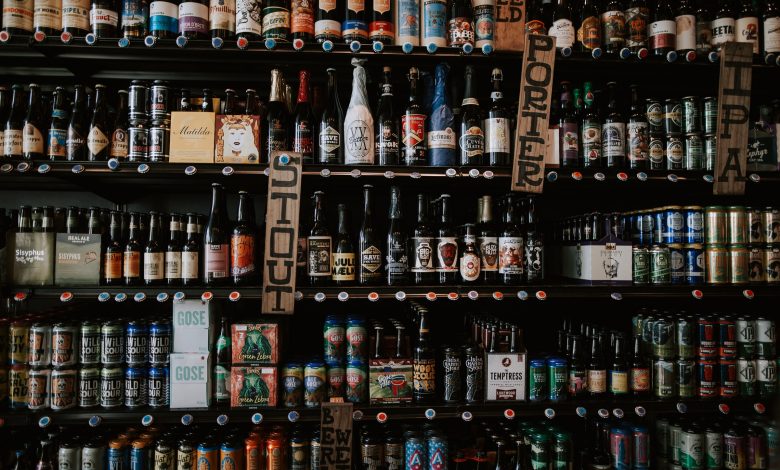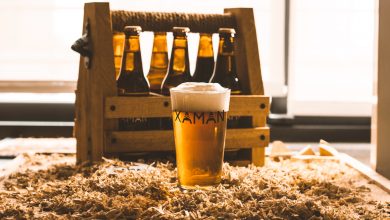What’s the Difference Between Porters and Stouts?

Among beer enthusiasts – brewers and drinkers – no question causes more confusion than the difference between porters and stouts. So many theories abound, especially among those who prefer one to the other, that it’s hard to tell what differentiates the two kinds of beer.
The fact that beer enthusiasts cannot agree on what separates these two isn’t surprising when you consider the startling similarities they share. Both are dark-colored shades of beer, with almost like-for-like correspondence in ingredients, aroma, and flavor.
However, differences still exist, albeit small and rather subtle, and picking them out requires that we first understand how both kinds of beer developed historically.

Historical Development of Porter and Stout
Historical Development of Porter
Historically speaking, between the two, porter originated first around the 18th century as a dark-colored shade of beer with a malt-flavored taste. Brewers across London brewed porter with malt because the dark-colored malts counteracted the local water’s mineral content.
While documenting the history of porter, John Feltham notes that a brewer named Harwood around the year 1730 created it from the recreation of a popular beverage in London called three threads. Three threads comprised of a third of a pint each of ale, beer, and twopenny. Initially, Harwood had named his new invention entire or entire butt, but it would eventually be famously renamed porter.
Historical Development Of Stout
Feltham’s claims – which he got from a letter written in the 1760s by Obadiah Poundage – are, however, mostly debatable since there’s no contemporary historical evidence to back them up. Despite this, the beverage was still a hit among beer drinkers in England, and more brewers took to making porter as a result.
Staying true to their nature, they also began to experiment and try out new recipes and blends of porter, thus, giving birth to stout. When stout initially came into the beer markets, it was easy to differentiate it from porter, as it was higher in alcohol than its counterpart. It was initially called “stout porter” in its early days, pointing to the fact that it was a porter with higher and stronger alcohol content.
It was around this period that Authur Guinness began brewing beer in Ireland. He would eventually go on to become a household name in the Irish and global beer markets. Guinness brewed both porters and stouts, with the first Guinness beers produced initially called single stout – or porter – and double stout.
The term stout initially referred to the alcoholic strength of a beer, with the double stout significantly punchier than the single stout. The word stout means “bold” or “strong. It was first used around the 17th century to describe any strong beer before it became used to describe a more powerful version of porter. However, the beer industry has experienced lots of changes, especially with the experimenting nature of brewmasters across the world.
The Beer Industry Today
With decades of experimentation among beer brewers, different varieties of porters and stouts exist, each with a unique blend of its ingredients. The tweaks initiated by various brewmasters worldwide have blurred the lines of difference between porter and stout, more so now than ever. You can no longer tell the difference between both of them based on alcohol content alone.
Most brewers now brew stouts that are lower in alcohol content and strength than porters, yet they still refer to them as stouts. The same applies to porters that are stronger than stouts but are called porters. Given these blurred lines of differentiation, lots of confusion crops up among beer enthusiasts on what separates a porter from a stout. Or are the two the same?
There are differing views to that question among beer enthusiasts, though, with each pointing out specific unique characteristics that separate the two kinds of beer. Even though most of these characteristics are arguable when it comes to differentiating the two beer types, they’re still worth examining.

Unique Differences Between Porter and Stout
Type of Barley and Malt Used
One of the significant differences between porters and stouts is in the type of barley and malt used to brew both kinds of beer. Most brewers say that stout is brewed with roasted barley and porter with unroasted malt barley. The roasted barley used in brewing stout is what accounts for its coffee-flavored taste.
Also, there’s the use of chocolate malt for brewing porters and patent malt for stouts. Of course, many argue that these two ingredients don’t count as a difference between the two kinds of beer. That’s because stout was first brewed when roasted barley was an illegal ingredient, and patent malt hadn’t been invented.
Also, the kind of malt or barley used in brewing either of the two types of beer is subject to the brewer’s discretion. Most brewers use any of the malt or barley mentioned above regardless of whether they’re brewing porters or stouts.
Taste
Another unique difference between porters and stout is in their respective tastes. Porters are said to have a paler, drier taste than stouts, albeit with a chocolate-flavored feel due to the use of malted barley in it’s brewing. Stouts, on the other hand, have a stronger taste, with a coffee-flavored taste due to the roasted barley used while brewing it. Again, this is arguable since most brewers alternate between malted barley and roasted malt regardless of whether they’re brewing porter or stout.
Body
Porters are generally lighter than stouts, which are fuller and denser. When brewers first brewed stouts, their fuller, thick feel accompanied their strong taste and high alcohol content. This heaviness and high alcohol content are why stouts are usually called stronger porters.
Of course, the experimental nature of brewers means some stouts are lighter and more thin-bodied than most porters and vice versa. This feature again alludes to the fact that there are no rules regarding how a stout or porter should look, taste, or feel. The brewer decides how best to brew their beer, depending on how creative they want to be.
Color
While both porters and stouts are dark shades of beer, there are varieties in their coloration that differentiate the two. Stouts are opaque, with a much deeper shape of brown or black. Porters, on the other hand, while also opaque, have a deep shade of brown to mahogany.
Aroma
The aroma of either porter or stout depends on the type of malt or barley used in the brewing process. Stouts have a more roasty aroma than porters because they contain roasted barley. Although, some brewers say some porters can have a malty roastiness to them in terms of their aroma; generally, stouts are “roastier.”
Alcohol Content
The alcohol content is another one of the differences between porters and stouts that most brewers and drinkers of beer admit. As mentioned earlier, in the early days of both porters and stouts, the latter had the highest alcohol content, and most beer enthusiasts agree this is still the case today. Of course, this doesn’t change the fact that we have stouts with significantly lower alcohol content than most porters, which, again, depends on the brewer’s discretion.

Types of Porter
Different varieties of porter exist today, thanks to the experimental tweaking of brewmasters across the world. These varieties differ from the original porter brewed in the 1700s. They’re more refined in style than their drier counterparts of the 17th century. We’ll look at some of these varieties of porter briefly:
English Porter
The English Porter is a light to dark brown beer that comes in two variants: brown and robust. The English brown porter is a malty beer that comes in bittersweet chocolate, caramel, or toffee flavors. On the other hand, the robust porter is a more intense beer due to the use of roasted or black parent malt in brewing it. It’s considered a close cousin of stout due to its robust nature.
Baltic Porter
Baltic porters are dark copper to dark brown beers that come in chocolate, licorice, and toffee flavors. The Baltic Porter follows the same style as the English Porter, but with higher alcohol content. It’s a close variant of the Russian Imperial stout.
American Porter
The American Porter also takes its inspiration from the English variant, but it’s more complicated in style. It is dark brown to black, with a smoky-malty taste.
Types of Stout
Like the porter, stouts come in many variants, some more robust than others. We’ll look at some of these variants briefly:
Irish Stout
Irish stouts are dark brown to black. They are drier in taste and do not possess the malty sweetness of other variants. They also come in chocolate, coffee, and toffee flavors.
Russian Imperial Stout
England first brewed the Russian Imperial stout for the Russian Imperial court in the 1800s. This stout is the most robust style of stout there is. It’s dark coppery brown to black, with a fruity, chocolate-flavored taste.
English Stout
The English Stout is a brown to jet black-colored beer that’s very similar to the Irish variant. It has a roasty-flavored bitter taste and is moderate in alcohol content.
American Imperial Stout
The American Imperial stout, also called American Double stout, is the American-styled version of the Russian imperial stout. It has the same creamy feel and robust alcohol intensity.



